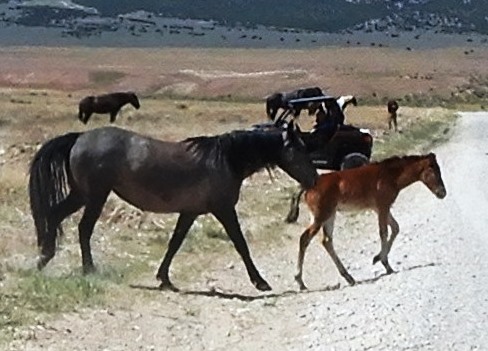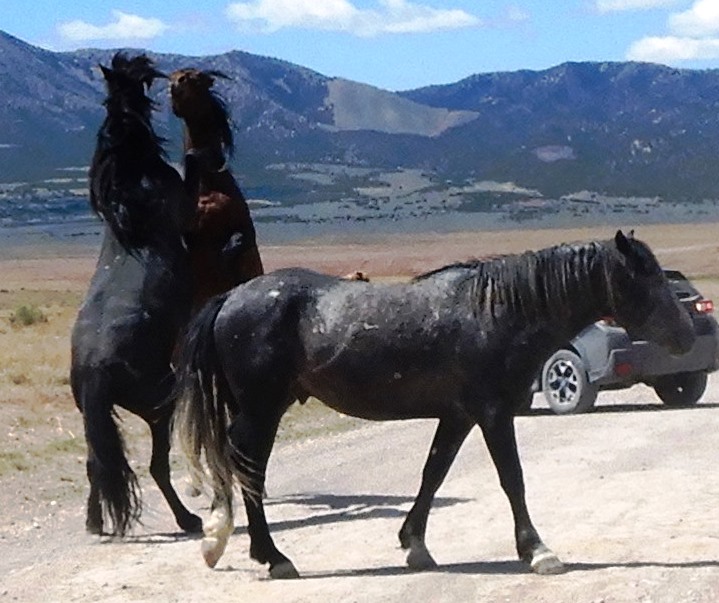Riding the Pony Express Trail on 52 horses | Adventures with Quadman
Quadman as he goes - Riding the Pony Express Trail
Riding the Pony Express Trail on 52 horses
By Lynn R. Blamires
We have ridden the Pony Express Trail before, but on this ride, I saw the trail through new eyes. We were riding in my Kawasaki Teryx4 LE with my brother-in-law, Mike Timothy, and his wife, Katherine. She had a great, great grandfather who was a Pony Express Rider.
Josiah Rogerson was 15 years old when he came across the plains to Salt Lake City which would have made him 19 when he mounted a wild mustang for his first ride with the Pony Express.
As we were trailering to our drop point on this historical route, we stopped at the location of the Pony Express station at Faust and at Lookout Pass. We unloaded in a field at this last station to begin our ride.
The Pony Express Trail is more of a road than a trail. It is suitable for cars and trucks, but if a person were to ride the trail for any distance, a 4×4 vehicle would be more appropriate.
We left the site of the Lookout Pass station and headed for Simpson Springs. We were almost eight miles into our ride when we encountered a herd of wild horses. As near as I could tell, some of these are descendants of those ridden by the Pony Express riders.
Arriving at the Simpson Springs station, we noted the efforts that have been made to preserve this interesting piece of history. At this site, we were introduced to what the Pony Express was about.
A replica of the original station has been built to give an idea of what life on the trail was like. Various placards around the site give information on this brief period of history. It seems like life at one of these stations could be described as days of boredom spiked by moments of sheer excitement when a rider came in for a change of horses.
I learned some very interesting facts in my research on the subject:
- The idea came to be from the need for faster communication between the east and west coasts.
- War was about to break out between the states and there was a desire to keep California in the union.
- The Pony Express mail cut the time from several months to an average of ten days for a message to make it across the country.
- The initial cost of a ½ ounce letter was $5 in 1860. In 2020 dollars, that would be $154.45. Yikes!
- A rider was paid $25 per week. That would be $772.25 per week today. The advantage the 1860 rider would have had is that his pay didn’t have taxes and social security deductions.
- The organization existed for a short period of about 19 months before the more efficient and less costly Transcontinental Telegraph brought it to an end.
We concluded our exploration of the Simpson Springs station and headed to the campground located there. We found a shaded picnic table for lunch. We had prepared sloppy joes which we had kept hot in a lunchbox oven plugged into the power outlet on the Kawasaki.
With lunch over, we decided to do some exploring. A trail exited the campground to the south which we took. Actually, we didn’t decide. I was driving so I just took it without asking anybody.
I thought we were heading up Indian Canyon which would have taken us over to Government Creek on the other side of the mountain. I found out later that we were traveling up Simpson Canyon and I had no idea where that would take us.
It is a pretty canyon. The rabbitbrush was in full bloom and it had a pleasant fragrance. A lizard scampered out of the brush and stopped long enough for us to see that he was a ringed-neck lizard.
I was enjoying the winding trail, but as I continued, I realized that the needle on the fun-o-meter for the passengers in my buggy was dropping rapidly. We were off the main trail and alone. If we had run into any trouble the chances for help were diminishing.
Turning around, we headed back down the canyon driving the needle back into the fun zone. We made it back to the Lookout Pass finishing a ride of about 38 miles. This trail is best ridden in the spring or fall.
As we rode this trail, we thought about the experiences young Josiah Rogerson might have had carrying the mail in this remote section of the country. When you go, take plenty of water, keep the rubber side down, and let your mind go back 160 years.


































